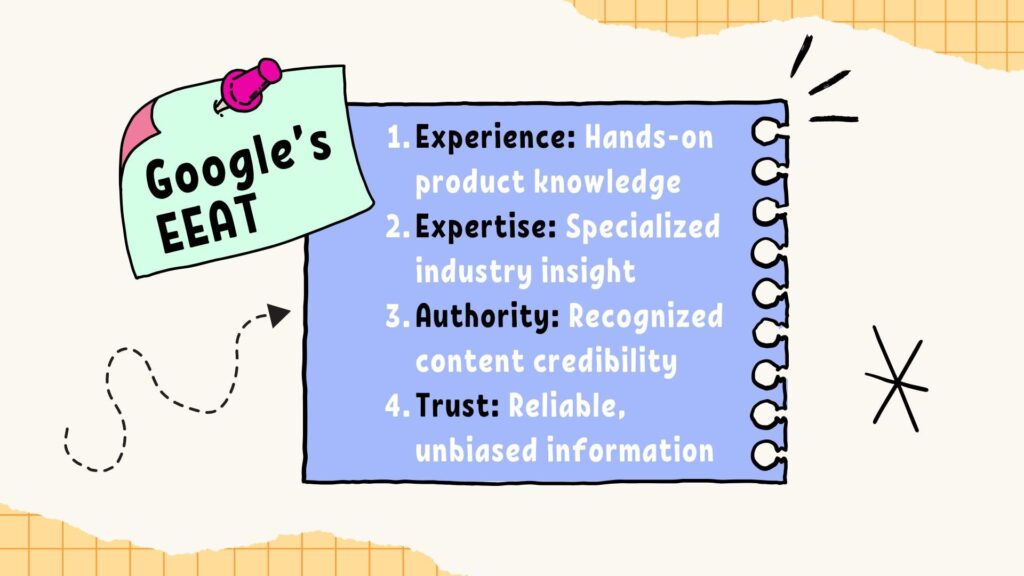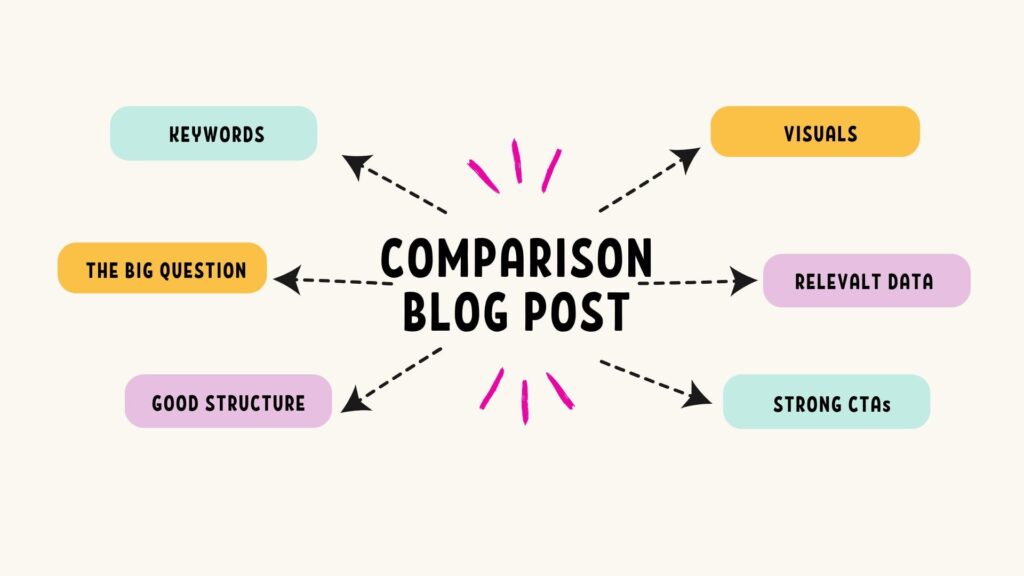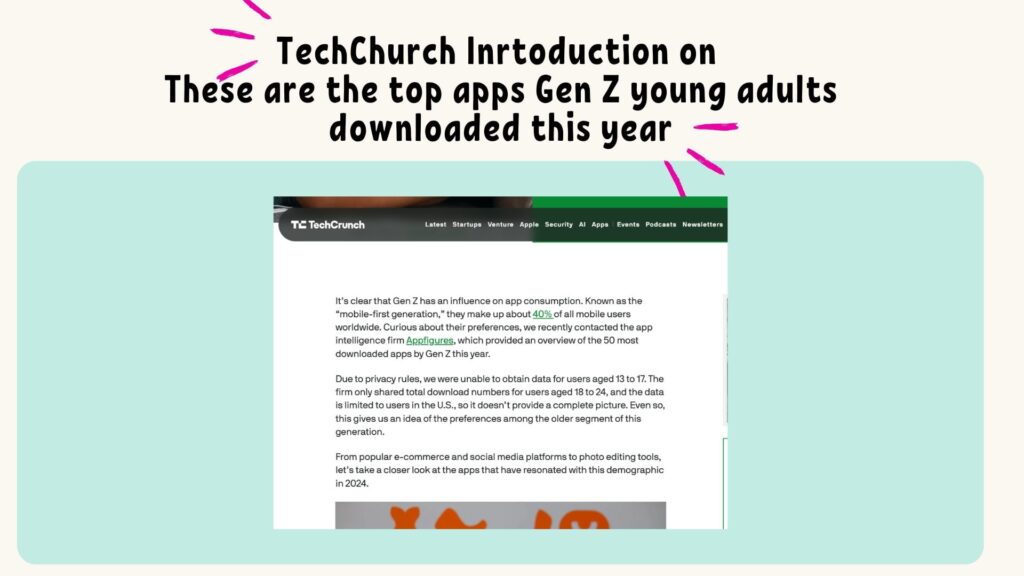In today’s crowded digital space, comparison posts are gold! Readers use them to make informed decisions, and companies love them because they drive real results—like increased traffic, higher engagement, and better conversions.
But the reality is—many businesses churn out comparison blogs that barely scratch the surface—and their readers can tell. That’s because crafting a post that truly hits home takes more than lining up features and hoping for the best.
To stand out, your post must prove your expertise—show readers you’ve used these products, know their ins and outs, and can offer real, unbiased insights. This isn’t just about comparing features; it’s about showcasing first hand experience with the products/services you’re reviewing, building authority, balancing promotion with genuine value, and helping readers make informed decisions they can trust.
Luckily, a few key strategies can make all the difference.
In the next sections, I’m pulling back the curtain on how to do just that—plus I’ll throw in a few tips Google loves to see.
The Secret Ingredients of High-Converting Comparison Posts: Building E-E-A-T

Comparison posts help readers make informed decisions, answer their questions and—when done right—showcase your brand’s credibility.
But what’s the secret to crafting a comparison article that actually converts? It’s Google’s E-E-A-T (Experience, Expertise, Authoritativeness, Trust) guidelines.
E-E-A-T is the gold standard Google looks for, especially in posts that steer buying decisions. Nail it, and you’re not just informing your target audience—you’re winning their trust.
How to showcase EEAT within your comparison post

- Showcase your experience and expertise: Let readers know why they can trust your insights. If you’re comparing software, mention your background in the industry or share real-world examples. Make it clear that you’ve worked hands-on with the products or services you’re discussing.
- Establish authority: Building authority goes beyond linking to credible sources. it’s about showcasing your own expertise and trustworthiness. Include testimonials from happy clients, highlight press mentions, feature your portfolio, and share your knowledge through blogs, podcasts, or YouTube videos.
- Build trust: Readers appreciate an unbiased take that highlights both pros and cons——it shows honesty. Add real customer reviews or testimonials to back your claims, offering a genuine glimpse into user experiences. When combined, transparency and authenticity create the foundation for trust.
Remember: E-E-A-T isn’t just for Google—it’s your blueprint for building reader loyalty. By consistently delivering trustworthy, expert content, you position yourself as the go-to source in your niche, keeping readers coming back for more.
How to Create a Comparison Blog Post That Readers Love (and Google Loves Too!)

If you’re serious about crafting a post that truly engages your readers and leads them to a conversion, you’ll need to dive deeper and get it right, from the post structure down to the tiniest details. Here’s how to make it count:
Step 1: Perform keyword research
Start by finding high-intent keywords that your target audience actually searches for. Your goal is to reach readers who are actively comparing options. Use keyword research tools like Semrush to uncover terms that people are searching for.
For an extra boost, write in SurferSEO. It helps you optimize your content for relevant keywords.
Step 2: Focus on the BIG question (search intent)

What’s going through your reader’s mind? What are they genuinely curious about? Building your post around real user questions and structuring it in a way that immediately addresses the user’s search intent makes it more engaging and relevant.
Check platforms like Quora, Reddit, and Google’s “People Also Ask” section for questions that real people are asking. Answer these specific queries in your post head-on so they know they’re in the right place.
Step 3: Reader-Friendly structure that boosts SEO
If readers can’t skim your post easily, they’ll lose interest. Content design involves crafting a well-structured post where each section stands out clearly. Use concise subheadings, bullet points, pros and cons tables, comparison tables, and bold text to organize your content and make it scannable. Aim for lean sentences that get to the point fast, ensuring each paragraph delivers something valuable.
Remember, a clear structure isn’t just reader-friendly—it also helps search engines understand and rank your content more effectively.
Step 4: Add visuals that speak volumes
Posts with visuals get 94% more views, so make sure each graphic adds clear, easy-to-scan value. Use tables, infographics, and icons to make your complex information simple and clear. Visuals capture attention, make data more memorable, and keep readers scrolling.
Step 5: Add some data to seal the deal
Trust is essential, and data-backed information builds trust. Sprinkle in relevant statistics, industry reports, real customer reviews, and/or expert opinions that back up your points. Readers are more likely to convert when they see solid evidence behind your claims.
Step 6: Insert strong calls to action

A well-crafted comparison post should naturally lead readers toward the next step. Your comparison blog should subtly remind them why they’re here and encourage them to take action. Use helpful CTAs that feel like a gentle nudge rather than a hard sell.
Avoid These Common Comparison Post Pitfalls

Even the best topics can fall flat if they’re not handled right. Here are some pitfalls that can make your post less effective—and how to avoid them.
1: Bias kills credibility
A one-sided post feels like a sales pitch. Instead, aim for a balanced view. If you’re writing product comparison blog posts and want to promote a particular tool, then be transparent about why it stands out while giving fair coverage to its competitors.
2: Overwhelming jargon
Trying to sound too technical? Tone it down. Over 80% of readers prefer plain language, even when discussing complex topics. Keep it simple, and don’t assume your audience knows the ins and outs of industry lingo. If a term is essential, give a quick explanation. Simplifying the language helps readers feel informed—not overwhelmed.
3: Ignoring SEO
SEO isn’t just a checkbox—it’s the lifeline of visibility. In fact, 70% of clicks go to the first five organic results on search engines. Use target keywords, optimize headers, and include relevant alt text for images. Internal linking is crucial, too, as it boosts page authority and keeps readers exploring your site.
4: Weak CTAs or none at all
Every comparison post should drive action. Without a strong CTA, readers are left hanging, unsure of where to go next. Your role is to guide them toward the logical next step—whether that’s signing up for updates, exploring your services, or booking a consultation. However, keep it subtle. A good CTA should seamlessly guide the reader toward the next step without the “hard sell” vibe.
Comparison Blog Post Template: Your Step-by-Step Guide

Need a clear framework? Here’s the structure that will keep readers engaged from start to finish:
1. Introduction: hook them fast!

Your first sentence is make-or-break. Start with a relatable hook that speaks to the reader’s problem.
Why are they here?
What decision are they trying to make?
Stats show you have 8 seconds to convince them to keep reading, so make it count! Use the SPEAR framework—Specificity, Problem-solving, Empathy, Authority, and Relevance—to craft an intro that resonates with every segment of your audience. Highlight their challenges, hint at tailored solutions, and set the stage for insights that speak to all readers.
2. Quick overview: what are the key differences?

People love efficiency: 73% of readers skim articles before diving deeper. Start with a quick summary—think of a comparison table or clear bullet points. This “at-a-glance” section gives readers the key points upfront and sets the stage for a more detailed breakdown.
3. In-depth analysis of each option
Readers want specifics. Dive into core features, pricing, ease of use, customer support, performance, value for money, etc. Studies show that 75% of users express trust in reviews, so remember to weigh the pros and cons without bias. A neutral tone is key to building trust, which is essential if you’re aiming for conversions.
4. Practical examples and use cases

This is where you make it real. Show how each option shines in real-world scenarios. Include relatable examples, videos, and customer reviews. This gives readers a clearer picture of what to expect and how each option could fit their needs.
5. Recommendation: which option is best (and for whom)?

Wrap up with a tailored recommendation. This section should give readers clarity on which option aligns with their needs, whether it’s best for budget-conscious users, tech-savvy experts, or those needing high-level customer support.
6. Call to action section
End with a CTA that feels natural, not forced. Whether it’s “Book a Free Consultation” or “Explore More Options,” make sure it guides them toward the next step. A clear CTA can increase conversion rates by 121%, so don’t underestimate its impact!
Real-Life Example: How New York Times Wirecutter Comparison Posts Drive Conversions

Wirecutter is known for its detailed product reviews. Their comparison posts don’t just inform—they convert.
So what makes Wirecutter so effective?
1. Unbiased, in-depth testing
Wirecutter’s team tests each product thoroughly, giving readers confidence in their reviews. They dig into details most readers might not even think of, like usability under specific conditions or long-term durability. They don’t shy away from mentioning cons, and this transparency is a big part of why readers trust them.
2. High E-E-A-T standards

Wirecutter builds its posts on the principles of E-E-A-T. Each review is enriched with thorough research, insights from industry experts, and real-world user feedback, giving readers a reason to trust every recommendation.
3. Long-form content that leaves no stone unturned
Wirecutter’s product comparison articles are in-depth, often 2,000+ words, yet remain reader-centric. By covering every angle—from product setup to alternatives—their long-form content answers all possible questions a reader might have.
4. Engaging, reader-friendly content design

Wirecutter masters the art of content design. They break down dense content into bite-sized, reader-friendly sections with bold headers, bullet points, and short paragraphs. Eye-catching images, product comparison charts, and highlighted key features make their pages scannable and engaging.
5. Personalized recommendations for every reader

Unlike generic reviews, Wirecutter often includes sections like “Best for Casual Use” or “Best Budget Pick,” which cater to different reader needs. This segmented approach means that readers find solutions tailored to their specific circumstances, making them feel understood and increasing the likelihood they’ll follow the recommended actions.
6. Clear calls to action

Wirecutter’s CTAs aren’t just “Buy Now” buttons—they’re strategically placed nudges that feel natural in the reading flow. They use soft encouragements, like “Sign Up,” that make it easy for readers to make a decision without feeling pressured.
Ready to Step Up Your Comparison Content? Let’s Make It Happen!
Crafting comparison posts that engage and convert isn’t easy—but it’s a game-changer. And if you’re ready to elevate your content game but you feel like you can’t do it alone, I’m here to help. Book a content strategy call with me, Craig Dewart, to discuss how My Content Pal can create comparison posts that drive results.
FAQs
What is an example of a comparison?
A classic example of a comparison is the analysis of two popular smartphone models—such as the iPhone and Samsung Galaxy. You can compare their features, performance, camera quality, and pricing. This helps potential buyers weigh their options and choose the device that best suits their needs.
What are the three types of comparisons?
The three main types of comparisons are:
- Similarities: Common traits, characteristics, or features shared between two or more subjects. It highlights how they are alike.
- Differences: Distinct characteristics that set subjects apart from one another. It showcases contrasts that can help clarify unique aspects or benefits of each subject.
- Analytical comparisons: A deeper evaluation of the subjects, combining both similarities and differences to provide a comprehensive understanding.
Conclusion: Elevate Your Comparison Content with My Content Pal
Comparison posts are invaluable tools for capturing interest, building authority, and driving action. By focusing on E-E-A-T, search intent, and clear calls to action, you can create compelling comparison posts that convert and resonate.
If you’re ready to craft posts that stand out, contact My Content Pal. With our Dedicated Writers, Editing Services, and Keyword Research, we’re here to make your content a standout success!





